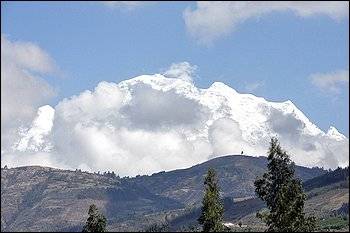
HUARAZ, Peru - Glacier melt hasn't caused a national crisis in Peru, yet. But high in the Andes, rising temperatures and changes in water supply over the last 40 years have decimated crops, killed fish stocks and forced villages to question how they will survive for another generation.
Without international help to build reservoirs and dams and improve irrigation, the South American nation could become a case study in how climate change can destabilize a strategically important region, according to Peruvian, U.S. and other officials.
"Think what it would be like if the Andes glaciers were gone and we had millions and millions of hungry and thirsty Southern neighbors," said former CIA Director R. James Woolsey.
Peru is home to 70 percent of the world's tropical glaciers, which are also found in Bolivia, Ecuador and Chile. Peru's 18 mountain glaciers, including the world's largest tropical ice mass, are critical to the region's water sources for drinking, irrigation and electricity.
Glaciers in the South American Andes are melting faster than many scientists predicted; some climate change experts estimate entire glaciers across the Andes will disappear in 10 years due to rising global temperatures, creating instability across the globe as they melt.
If Peru and its allies don't fund and create projects to conserve water, improve decrepit water infrastructure and regulate runoff from glaciers within five years, the disappearance of Andean glaciers could lead to social and economic disaster, said Alberto Hart, climate change adviser at Peru's Ministry of Foreign Affairs.
"This will become a problem for the United States," he said. "When you have a dysfunctional country, you have a problem for the entire region."
The United States spent $30 million on climate change assistance in Peru in fiscal year 2010, according to documents provided by the State Department. The funding, allocated as part of the 2009 Copenhagen Accord, went mostly to preserving the Amazon rainforest in Peru.
Peruvian officials would hardly turn away money to preserve the Amazon. But the immediate problem is adaptation to rapid glacier melt, Hart said.
The U.S. Agency for International Development, which administers the majority of climate funds, recently received a $1.25 million grant to work with The Mountain Institute, a Peruvian non-profit organization, through 2012 and assist mountain communities in adapting to glacier melt.
"It will take more resources than are currently available . . . but the trend is going in the right direction," said Steve Olive with USAID in Peru.
The Peruvian government is asking Washington and other allies for at least $350 million every year through 2030 to build reservoirs and dams, and improve irrigation, said Hart.